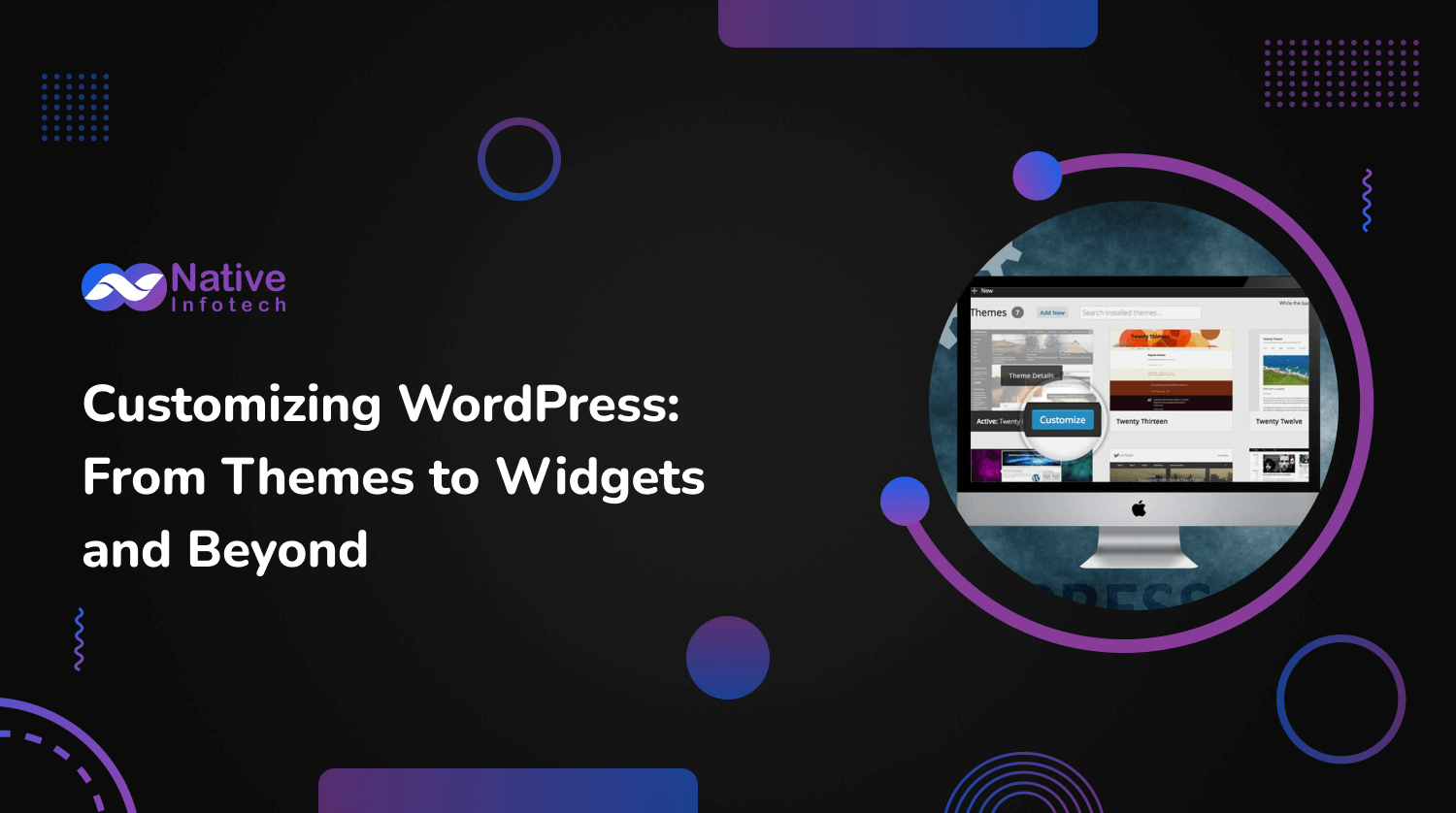
WordPress is the top choice for making websites, powering about 40% of all online sites. It’s popular because it’s flexible, can grow with your needs, and is easy to use. This makes it great for bloggers, small business owners, and big companies alike. In this guide, we’ll explore how to personalize WordPress. We’ll look at how to pick the best theme and how to add more features with widgets and plugins.
Why Customize WordPress?
Customizing your WordPress website is essential because it allows your site to be unique and distinguish itself from countless others on the internet. By personalizing your site, you can create a visual and functional experience that captures the essence of your brand or personal style, making it more appealing to visitors.
Furthermore, customization enhances the user experience by making your site more intuitive and easier to navigate. This can lead to better engagement with your content as visitors find it more enjoyable and straightforward to use. Custom features and layouts can help guide your audience to the most important information and actions, potentially increasing conversion rates.
Additionally, tailoring your WordPress site to specific requirements can greatly improve its functionality. By adding specific plugins and widgets, you can introduce new features and capabilities that are not part of the standard WordPress package. This could include anything from e-commerce solutions and social media integration to advanced analytics and more interactive content forms.
Overall, customizing your WordPress site not only makes it more attractive and user-friendly but also enhances its capabilities, making it a more effective tool for meeting your online goals. This customization leads to a better user experience, increased user engagement, and potentially, better performance of your site in terms of both traffic and conversions.
Choosing the Right WordPress Theme
What to Look For in a Theme
When choosing a theme for your website or digital platform, it’s important to prioritize several key aspects to ensure that it effectively represents your brand and provides a seamless user experience. The design of the theme should not only be visually appealing but also align closely with your brand’s identity, reflecting its values and aesthetics. This helps in creating a consistent brand experience across all user interactions.
Responsiveness is another critical factor. The theme must be responsive, meaning it should automatically adjust its layout to look good and function well on a variety of devices, from desktops to smartphones. This is essential as more users access websites via mobile devices, and a mobile-friendly design can significantly enhance user engagement and satisfaction.
Ease of use is equally important. The theme should be intuitive and straightforward, enabling users to navigate your site effortlessly. This includes clear navigation menus, readable fonts, and accessible design elements that cater to all users, including those with disabilities.
Overall, selecting the right theme involves a balance of these elements—design, responsiveness, and ease of use—ensuring that it not only looks attractive but also works efficiently and aligns with your overall brand strategy. This approach will help in attracting and retaining users, ultimately supporting your business goals.
Premium vs. Free Themes
| Feature | Free Themes | Premium Themes |
| Cost | Free | Paid (one-time or subscription fee) |
| Customization | Limited options | Extensive customization options |
| Advanced Features | Basic functionality only | Advanced features like SEO tools, e-commerce support, responsive designs |
| Support | Minimal or community-based | Dedicated technical support |
| Updates | Less frequent | Regular updates |
| Ideal for | Beginners, small personal projects | Businesses, professional websites |
| Long-term Viability | May need to upgrade as needs grow | Better equipped for growth and scalability |
Installing and Customizing Themes
How to Install a Theme
- Go to your WordPress dashboard.
- Navigate to Appearance > Themes > Add New.
- Search for a theme or upload one, and then click Install and Activate.
Customizing Your Theme
Most website themes are equipped with a built-in customization tool, often referred to as a customizer. This feature provides users with the flexibility to modify various aesthetic aspects of their website directly from the dashboard. By navigating to the “Appearance” section and then selecting “Customize,” users can access a range of settings that allow them to alter elements such as colors, fonts, and overall layout. This customizable approach enables website owners to tailor the appearance of their site to better match their branding or personal preference, enhancing the user experience and visual appeal. The customizer is user-friendly and designed to provide immediate visual feedback, making it easy for even those with minimal technical expertise to make their site visually engaging.
Enhancing WordPress with Plugins
Plugins are essential add-ons that significantly enhance and expand the capabilities of a WordPress website. These tools are designed to seamlessly integrate with your site, allowing you to add a wide array of features without needing to write any code yourself. Whether you’re looking to improve your website’s search engine optimization (SEO), connect with larger audiences through social media platforms, or bolster the security of your site, there is almost certainly a plugin available that can meet your specific requirements. The vast library of available plugins means that virtually any functionality you might envision for your website can be implemented easily, enabling you to tailor your site to better meet your goals and the expectations of your visitors.
Essential Plugins for Every WordPress Site
- Yoast SEO: Optimizes your site’s SEO.
- Jetpack: Provides design, marketing, and security features.
- WooCommerce: Transforms your site into an e-commerce store.
Utilizing Widgets in WordPress
Widgets are compact, versatile components designed to execute specific functions on your website. They can be added to various designated areas of your site, such as the sidebar, footer, or any other sections that are prepared to accommodate widgets, often referred to as “widget-ready areas.” These tools are instrumental in customizing and enhancing the functionality of a website without the need for extensive coding. Widgets can perform a range of tasks, from displaying recent posts, adding search bars, showcasing recent comments, to integrating social media feeds, and more. By using widgets, website owners can significantly improve the user experience on their site by making information more accessible and the layout more interactive and user-friendly. Essentially, widgets serve as practical building blocks that you can utilize to tailor your site’s design and functionality to better align with your specific needs and the expectations of your visitors.
Popular Widgets for WordPress
- Calendar: Adds a calendar of your posts.
- Recent Posts: Displays a list of your recent blog posts.
- Social Media Feeds: Shows your latest social media activity.
Advanced Customization Techniques
Using a Child Theme
A child theme in WordPress is a type of theme that derives its core functionality from another WordPress theme, referred to as the parent theme. This relationship allows the child theme to inherit all the styles, features, and the structural code of the parent while enabling extensive customization that doesn’t affect the parent theme. The primary advantage of using a child theme is that it allows website developers and designers to apply custom modifications and enhancements to the site’s appearance and functionality without altering the original theme files. This approach is particularly valuable because it safeguards customizations against being overwritten when the parent theme receives updates. By using a child theme, you can ensure that your modifications remain intact even after the parent theme is updated, thereby maintaining your site’s unique design and tailored functionalities over time. This system not only promotes greater flexibility in website design but also enhances stability and security by keeping the core theme’s code untouched and up-to-date with the latest updates, patches, and improvements.
Custom CSS
For individuals who possess some knowledge of coding, particularly in CSS (Cascading Style Sheets), there is the potential to make more precise and detailed adjustments to a website beyond what is available through the theme’s built-in customization options. Custom CSS allows users to directly modify the styling of their website, offering control over aspects such as layout, colors, fonts, and other visual elements. This method is ideal for implementing design changes that are not supported by the default settings of the theme.
Using custom CSS involves writing specific style rules that target elements within the website’s HTML structure, overriding the default styles provided by the theme. This can be particularly useful for achieving a unique look or for making adjustments that are specific to the needs of the site, such as adjusting the size and style of headers, fine-tuning the spacing between elements, or even creating custom animations.
Moreover, most modern themes provide a dedicated area within the theme customization panel where custom CSS can be safely added. This integration ensures that the custom styles are preserved during theme updates, preventing any loss of the custom tweaks made. Through the use of custom CSS, website owners and developers can enhance the aesthetic appeal and functionality of their site, tailoring it to exact specifications and improving the overall user experience.
Optimizing Your WordPress Site for Speed
Improving your site’s loading time is crucial for user experience and SEO. Optimize images, use a caching plugin, and consider a content delivery network (CDN).
Security Measures for WordPress
Keep your WordPress site safe from hackers and harmful software. Make sure to update your themes and plugins often, choose strong passwords, and add a security plugin like Wordfence to help protect your site.
Backup Solutions for WordPress
Always keep a copy of your WordPress site saved. Tools like UpdraftPlus can help you do this automatically, making sure you can get your site back if something bad happens.
Conclusion
Customizing WordPress can turn a simple site into a strong, effective, and specially designed online space. By choosing the best themes and plugins, and using widgets and custom CSS, you can make sure your site looks good, works well, and fits what your visitors need. Explore the customization features that WordPress provides, and start creating a site that really shows your ideas and goals.
Exploring the Future: 5 Big Changes Coming to Computers in 2024 and How to Get Ready
Are you ready to dive into the future of computing? The year 2024 promises to be an exciting time for technological advancements, with significant changes expected to revolutionize the way we interact with computers. From quantum computing to augmented reality, here are five big changes coming to computers in 2024 and how you can prepare…
WordPress Trends 2024: What’s New and What’s Next?
As we get closer to 2024, WordPress remains a top choice for creating websites, running a large part of the internet. It keeps changing and growing, making it important for developers, marketers, and business owners to keep up with the new trends. This article looks at the upcoming trends for WordPress in 2024, giving tips…
Best WordPress Ecommerce Themes in 2024
Using the best WordPress ecommerce themes will set your ecommerce business up for success. WordPress ecommerce themes are a great way to start your ecommerce business as they have a lot of advantages, including flexibility and cost-effectiveness. You can easily edit the templates according to your liking so that your ecommerce web design is unique…


